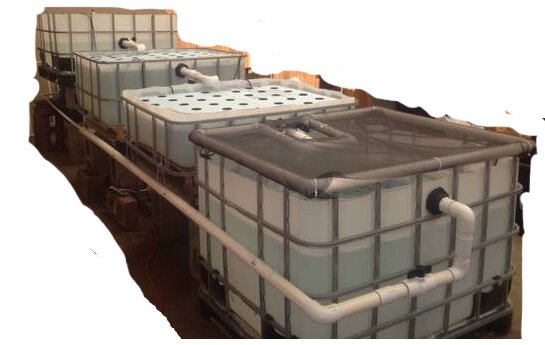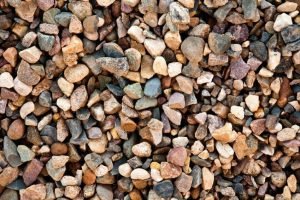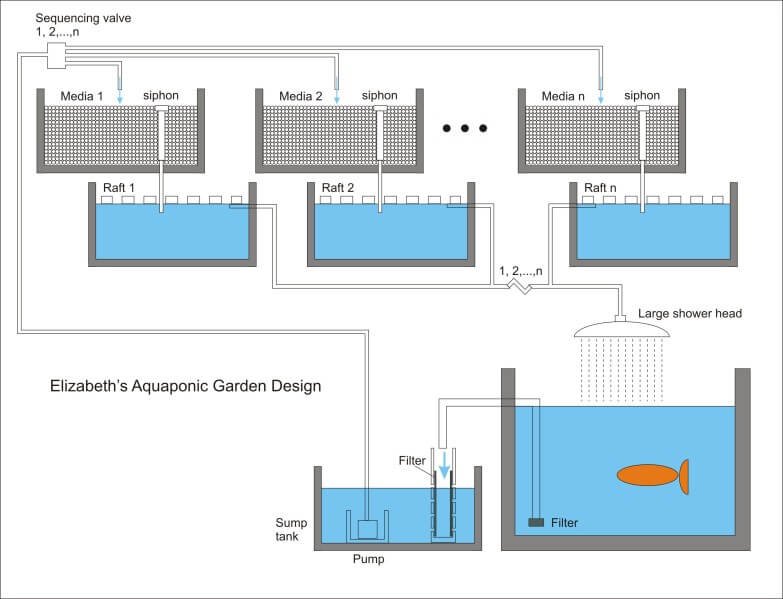We have experimented with cutting IBC’s in different ways to make solid waste removal easier
This week we are really pleased to share a guest posting from Nick at howtoaquaponic.com – a great introduction to IBC totes! Thanks Nick – and happy farming everyone!
It’s a fascinating and incredibly rewarding experience creating an aquaponics system and then watching it grow into a fully functioning plant and fish producing machine.
In fact, once you start looking into aquaponics it is almost inevitable that you’ll want to make your own system. There are several ways you can do this but making a DIY aquaponics setup with IBC Totes is one of the best and most cost effective.
You may be concerned that it is complicated, time consuming or costly. The reality, as you’re about to find out; is that it’s not!

What Is An IBC Tote?
An IBC is simply an Intermediate Bulk Container. In effect this is a container built to hold liquid; to be classified as intermediate it will hold approximately 250 gallons of water. You can go smaller, larger or even use multiple IBC’s when creating your own system.
It is possible to purchase an IBC tote from a variety of sources online or at your local gardening centre or even at an aquaponics specialist. However, you don’t need to!
There are plenty of other options to use as your water container.
Making A DIY Aquaponics Setup
There are several things you’ll need before you start making a DIY aquaponics setup:
- An IBC Tote or similar container x 2
- Pipes
- Water pump
- Grow Media
- Timer or auto siphon – depending on system type
Now it’s time to start building!
Your Container
It’s perfectly acceptable to purchase an IBC tote to create your set up. However, you can also opt for an old, but large fish tank, a rigid pond liner, an old oil or water drum or any other container you think is large enough to support your fish.
If you’re reusing a container then it is essential that you clean it thoroughly first; trace elements left in any kind of container could kill your new system before it has a chance to get started.
Note: You’ll need one fish for every square foot of growing area and each fish needs approximately 5 – 10 gallons of water.
You can use this to work out the size of your containers. For example, if you have a grow container 4ft by 2ft then you’ll have 8 ft of growing space. This means you need 8 fish and between 40 and 80 gallons of water.
You should note that in this example each fish is approximately 1 pound when fully grown. You’ll need to adjust your calculations depending on the type of fish you are intending to stock.
Don’t forget if you’re intending to grow your fish stock you may want to plan for a larger container or simply add a secondary one on later.
You can now purchase your IBC or locate and clean something ready for your aquaponics system.
Choose Your Location
Depending on the size of your setup and the weather you have through the year you may want to set your aquaponics system up outside. Alternatively you can try a small one in your home or set one up in the greenhouse. (This is the most common solution).
Position Your IBC
Now that you know where you’re going to set up your system you need to position your container. You should also position your container or containers for growing plants. These should be relatively shallow with flat bottoms.
You’ll need to have either a submersible pump in the container or a pipe exit point to an external pump unit.
The other end of this pump unit will need to come in at the bottom of the growing containers. It is a good idea to set your growing containers at a slight angle; 5° should do.
The water will come in at one side and naturally drain across the tray because of the angle.
At the lower part of your growing container you’ll need to drill a hole big enough for a pipe to take the water back to your fish container.
The easiest option for a first time aquaponics setup is to position a siphon valve on the top of this pipe. This will ensure the water flows back to the fish tank at a steady rate.
More complex systems forego the siphon and use a timer to flood and drain the growing tank.
If you wish you can have more than one growing container but each one needs to receive a good supply of water from the fish tank.
Growing Media
You can choose from a variety of growth medias but one of the best is ¾” river rocks. These are inexpensive to purchase and provide great drainage while giving the plants a good purchase point.

Simply layer this across the bottom of your growing container; the idea amount is between 6” and 12” of river rock.
If you’re looking at buying a tote you can cut the top of the tote to create your growing bed and use the lower half as your fish tank. This means you could actually stack the grow container on top of the fish and reduce the need for drainage pipes.
Get Started!
That’s it! You have a tank for your fish and a means of pumping the water through the plant bed to give your plants the nutrients they need. Providing the water returns to the fish tank you’re ready to go!
The first step is to fill your water tank. It is advisable to use a filter as this will remove the chlorine from your tap water. Or use rain water.
You’ll also need to turn your pump on as this will aerate the water and make sure all the chemicals are gone. It will take between 3 days and a week for this to happen; you won’t be able to add fish during this period.
Once you’re confident that you have the ph right and the chemicals are gone you can add your plants to the growing container. These will help to clean the water for the fish.
But, you must make sure there is no soil on these plants.
Planting is a simple as digging a small hole on the river rocks and slotting the plant in. Be careful not to damage the roots.
Your plant may wilt and take a few days to look healthy again; this is normal.
Now you can add your fish! You may want to take expert advice on which fish will best suit your system and plant growth but most cold water fish will do. For sustainable information about fish feed, check our article here.
All that’s left to do is test the ph and ammonia levels each week and keep an eye on your plants. If the system is working properly your plants will soon be a lot bigger!


Leave a comment